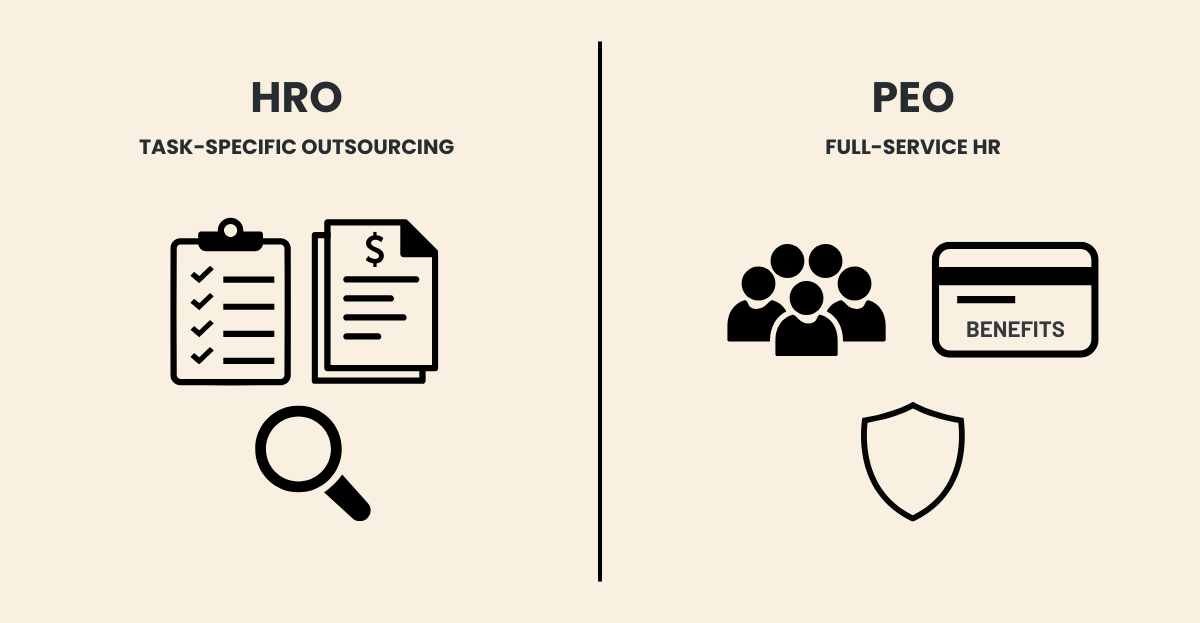Key Takeaways
- HROs and PEOs are distinct HR outsourcing solutions, each suited to different business needs and organizational sizes.
- PEOs establish a co-employment relationship and provide comprehensive HR support, including access to a pooled benefits program.
- HROs allow companies to selectively outsource HR tasks without sharing employer liability.
Introduction to HR Outsourcing
Navigating the landscape of HR outsourcing can be daunting for business leaders aiming to improve efficiency while minimizing risk. Human Resources Outsourcing (HRO) and Professional Employer Organizations (PEOs) are among the most popular solutions, but their differences often lead to confusion. For a deeper understanding of these two options, including their operational benefits and drawbacks, the HRO vs. PEO guide provides a comprehensive side-by-side comparison. Determining whether an HRO or PEO is the right fit for your needs is a strategic decision that can significantly impact company culture, compliance obligations, and long-term growth.
It’s essential to recognize how these two models serve unique business requirements. From payroll to compliance and benefits administration, both have different implications for your organization’s structure and employee experience.
What is Human Resources Outsourcing (HRO)?
An HRO is an external provider handling selected HR activities for a business. The relationship is transactional: the HRO takes on specific HR tasks, such as payroll processing, benefits management, recruitment, or compliance checks, based on your company’s preferences. Importantly, the business retains full control and accountability for employees, separating core operations from administrative support.
HROs offer maximum flexibility, making them ideal for companies with established HR departments or those that prefer to outsource only specific tasks. For instance, a large company might handle employee relations in-house but outsource benefits administration or regulatory compliance to ensure expert oversight.
What is a Professional Employer Organization (PEO)?
A PEO takes HR outsourcing a step further by entering into a co-employment arrangement. In this model, the PEO becomes the employer of record for payroll tax purposes, while the business continues to manage daily responsibilities and maintain its workplace culture. The PEO handles comprehensive HR services, including benefits administration, payroll, risk management, and workers’ compensation. According to People Managing People, this partnership allows companies to offload administrative burdens and focus more on core operations while ensuring compliance with evolving labor regulations.
This co-employment structure means that the PEO shares certain liabilities with your company and often extends large-group employee benefits, such as health insurance or retirement plans, usually at more favorable rates due to bulk purchasing power. Small and medium-sized businesses can thus access HR services and employee benefits typically available only to much larger enterprises.
Key Differences Between HROs and PEOs
Employment Relationship
With a PEO, your business and the PEO become co-employers. The PEO assumes administrative employment functions and certain legal responsibilities, while you retain authority over business strategy, day-to-day operations, and employee management. In the HRO vs. PEO comparison, this co-employment structure is a defining difference, HROs, by contrast, maintain a vendor relationship. You select specific HR services, but keep sole responsibility for employees and related legal exposure. According to Business News Daily, understanding these fundamental distinctions is crucial when determining which model best aligns with your company’s goals and compliance requirements.
For instance, if you are outsourcing for audit services you need to take care of related compliance that does not harm employee fundamentals.
Scope and Flexibility of Services
PEOs typically offer an all-inclusive package that includes payroll, benefits, HR compliance, risk mitigation, and sometimes talent management or training solutions. These bundles appeal to smaller businesses that lack a robust HR infrastructure or are seeking turnkey solutions.
Related Posts
HROs let you “pick and choose”, businesses can delegate only what makes sense for their size or operational complexity. This a la carte approach suits larger companies or those with unique HR needs.
Risk Management and Liability
In a PEO arrangement, risk and liability, such as payroll taxes, workers’ compensation claims, or regulatory penalties, are shared or shifted to the PEO. This can greatly reduce the administrative burden and potential financial exposure for your business.
With an HRO, all compliance obligations and risks remain with the business. The HRO provides expertise and services, but does not directly assume liabilities on your behalf.
Access to Employee Benefits
PEOs typically enable companies to access pooled benefit plans, leveraging their larger employee base to secure better rates and more robust offerings, including health insurance, dental and vision coverage, and retirement savings options. This can be a game-changer for attracting and retaining talent.
Although HROs can manage benefits administration, they do not facilitate access to pooled plans, your company negotiates rates and options independently.
Choosing the Right Solution for Your Business
The choice between HRO and PEO comes down to your organization’s size, internal HR capabilities, and appetite for sharing risk. Startups and fast-growing small businesses often prefer PEOs for their turnkey support and access to large-group benefits. Conversely, medium and large enterprises with an established HR backbone may opt for HROs to outsource only time-consuming or specialized tasks.
Consider your business’s growth trajectory, regulatory exposure, budget, and the level of control you wish to retain over the employee lifecycle. Talking to industry peers or consulting with unbiased HR advisors can also provide valuable perspectives tailored to your circumstances.
Conclusion
Understanding the core distinctions between HROs and PEOs is crucial for making informed, strategic decisions about HR outsourcing. Both offer compelling advantages, but the right solution depends on your business’s operational needs, growth plans, and internal resources. Carefully evaluating these models enables you to strike a balance between efficiency, compliance, employee satisfaction, and scalability, ultimately helping your company thrive in a rapidly evolving workplace landscape.










